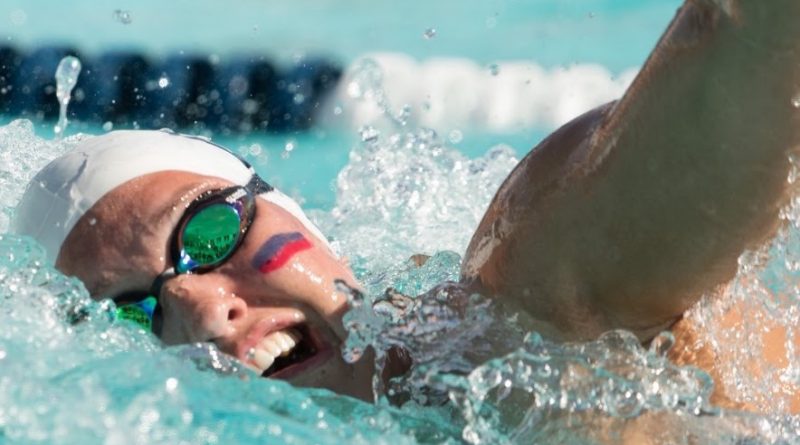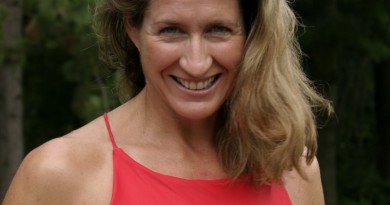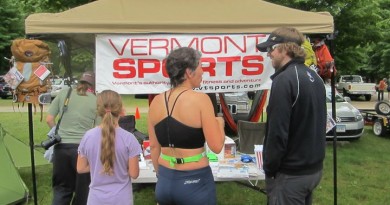Making A Splash: One Vermont Swim Club Creates Waves
Since it was built in 2009, the Upper Valley Aquatic Center has made ripples in the swimming world as coach Dorsi Raynolds keeps turning out Olympic hopefuls.
On the evening of June 27, 2016, at the Olympic Trials in Omaha, Neb., eight swimmers readied themselves on the CenturyLink Center pool deck for the 400-meter freestyle final–the race that would determine who would compete in Rio de Janeiro. Katie Ledecky, the world-record holder for the 400 freestyle, loosened her arms and secured her cap in lane four. Allison Schmitt and Lea Smith, both expected to qualify, flanked her in lanes three and five.
Lane one held an unlikely contender: 18-year-old Hannah Cox, from Hartland, Vt. Sporting a black legskin suit, her dark curls tucked under a matching black cap, Cox curled tightly into herself on the dive block, ready to spring.
The buzzer sounded and the women soared from their blocks, crossing the 50-meter pool in less than thirty seconds.
Ledecky pulled ahead, maintaining her world-record pace for six out of the race’s eight laps. Cox, just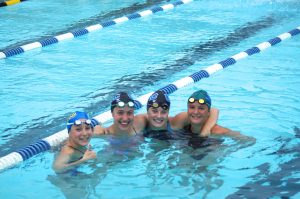 two lanes over, stayed on her tail for the first 100 meters, an arm’s length away from Ledecky’s feet. Then Ledecky shot forward. Cox pulled hard, her steady strokes pounding the water with rigor. The last to touch the wall, Cox missed a spot in the Olympics. Four of those women went on to compete in Rio.
two lanes over, stayed on her tail for the first 100 meters, an arm’s length away from Ledecky’s feet. Then Ledecky shot forward. Cox pulled hard, her steady strokes pounding the water with rigor. The last to touch the wall, Cox missed a spot in the Olympics. Four of those women went on to compete in Rio.
It is hard to believe that Cox, who grew up in tiny Hartland, didn’t have a coach or regular year-round swim practices until she was a freshman in high school. “She swam summers at the Woodstock Rec,” says Hannah’s mom, Karen Cox. Cox excelled early, becoming a Vermont State Champion at age 8. “The seven o’clock (evening) practice time was not ideal,” says her mother. “But I knew that UVAC would be built, so we made a promise to her that when it was finished, she could start swimming in the winters.”
In 2004, a group of parents in the Upper Valley rallied to raise funds to build an indoor pool. In 2009, the Upper Valley Aquatic Center opened its doors. A 37,500-square-foot-facility, it features a 10-lane competition pool, a separate warm water pool, a splash park with water features and waterslide, a state-of-the-art fitness center and a group fitness studio.
Best yet, it was a ten-minute drive down the road from the Cox’s home. There, Hannah’s swimming career began. But by then, she was already freshman in high school—getting a much later start than most Olympic-hopefuls. “We didn’t even know what year-round swimming really meant at the time,” Karen Cox said.
In short time, Hannah Cox became one of New England’s top swimmers, winning multiple Junior National Championships and competing in the World Junior Championships in Singapore. She currently holds the New England record for the 200 freestyle.
Cox acknowledges that the Upper Valley Aquatic Center was a big player in her swimming success, and moreover, that her life would have been much different without one person: her coach, Dorsi Raynolds.
“I’m so grateful, for one, that UVAC opened in a perfect place,” the college freshman said over the phone this spring. “It’s really cool how it all worked out. But then, to have not only a pool in a perfect place, but to also to have a coach who knew what she was doing—I’m really thankful for that, because without the proper training, my swimming career could have been totally different.”
INTENTIONAL THINKING
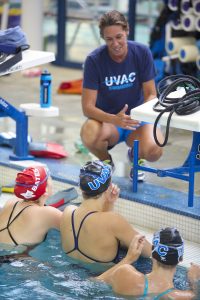 Earlier this winter, as one of UVAC’s six weekly practices was nearing its end, Raynolds shepherded the forty-odd team members, exhausted after an hour and a half of continuous swimming, to the deep end of the pool. Raynolds’ t-shirt bore evidence of the afternoon’s activities: wet splotches from standing too close to the splash zone and a wet attack-hug from a young, giggling swimmer.
Earlier this winter, as one of UVAC’s six weekly practices was nearing its end, Raynolds shepherded the forty-odd team members, exhausted after an hour and a half of continuous swimming, to the deep end of the pool. Raynolds’ t-shirt bore evidence of the afternoon’s activities: wet splotches from standing too close to the splash zone and a wet attack-hug from a young, giggling swimmer.
Counting off, she divided the teens into groups of six. Swimmers mounted the dive block as Raynolds belted instructions into the 85-degree humidity. A sprint: 50 yards of butterfly, but with “freestyle sprint” breathing. The high-schoolers groaned.
Raynolds laughed, shaking her head. “Just try it guys,” she said. “Failure is always okay.”
The assistant coach bellowed a “ready… go!” and six swimmers simultaneously pierced the water, rippling down the pool and back in near-perfect form.
Raynolds may have landed at UVAC by chance, but her story seems far from accidental. Eleven years ago, right about the time the group of Upper Connecticut Valley parents began fundraising to build an aquatic center, Raynolds was living in Madison, N.J. She had just spent 13 years at the University of Buffalo, where she had been the college’s all-time winningest women’s swim coach, and was coaching the women’s and men’s teams at Drew University. She had left Buffalo reluctantly in an effort to get closer to her hometown: Woodstock, Vt. Her parents were aging and she missed the Green Mountain state.
On a wall in her home office in New Jersey, she pinned up a map of Vermont and pushed a thumb tack into the intersection of I-89 and I-91. Drawing a 50-mile radius around the pin, she promised herself she’d find a coaching job within the circle.
“I did that three years before they built UVAC—it turns out they built this place on the thumb tack,” she said. “So I’m kind of a believer of intentional thinking.”
Raynolds, a tall, athletically-built woman with short, copper-colored hair, was an All-American basketball player, softball player and swimmer in high school. When she left for college in 1981, she knew she wanted to coach.
“I almost went to Indiana because I got recruited by my favorite swim coach, but I was too freaked out that swimming would become my life,” she said with a laugh. Instead, she enrolled at Ithaca, where she tried out for both basketball and swim teams. Finally, she chose swimming, understanding to some extent the role the sport would play far into her future.
“It’s an extraordinary mental sport to me. I think that’s why I ended up coaching it, because the mind is the thing that fascinates me most about human beings, and human potential is the thing that fascinates me most about living. That’s how I knew I wanted to be a coach—this thing called human potential.”
Before graduating, she recorded 16 All-American titles, four state champion titles and the New York State record for the 50-meter butterfly.
With a bachelor’s degree in physical education and a master’s in sports psychology from Boston University, Raynolds is qualified to coach at the collegiate level—something she did for over two decades. But now she enjoys working on the other side, where she can watch her swimmers get recruited and prepare them for the demands of college swimming.
“I got to see the other end of it,” she said. “I saw my calling in club swimming because there’s a lot more to influence at these ages, in terms of dedication and commitment and patience.”
As opposed to college swimming, coaching middle school and high school-aged kids calls for mind-molding as much as physical training. At UVAC, Raynolds teaches her youngest team members, thirteen-year-olds, to take “responsibility for choice.” Practices at UVAC are not mandatory—swimmers can come once a week, or they can attend all six evening and three morning practices.
“We do a goal meeting at the beginning of the year,” she says. “They fill out forms that not only state what their weekly attendance is going to be, but also ask, ‘why do you swim?’ If I notice a kid is wanting to take it seriously, I talk to them about what it’s going to take. You have to get out of bed in the morning. While we’re all here and uncomfortable at 5:30 a.m., you’re cozy in your bed. That’s the sacrifice.”
Because of UVAC’s flexible attendance policy, Raynolds and her assistant coaches manage non-competitive swimmers alongside swimmers who compete at national levels. With Hannah Cox off to college, Raynolds has zoomed in on 18-year-old distance swimmer Kristian Hansen.
Hansen, who was recently recruited by the University of Minnesota, has been swimming since he was eight years old. Over the past seven years, he’s emerged as one of the team’s fastest, second only to Cox, who he occasionally challenged. In December, he won the overall Distance Swimmer of New England Senior Championships by placing higher than his competitors in four categories: the 500-meter freestyle, 1,000-meter freestyle, 1,650-meter freestyle and 400-meter individual medley. Last summer, he qualified for the Summer Junior Nationals meet, one of the most challenging junior meets in the country.
Watching her swimmers compete at national levels—that’s what gets Raynolds up in the morning. In August of 2015, Cox qualified for the FINA World Junior Championships in Singapore. Raynolds went with her, serving as the assistant to U.S. Nationals coach Chuck Batchlor.
“We had to train for three and a half weeks at an incredible rate,” Raynolds said, “and she did everything I asked of her. She committed herself.” Cox came home with a bronze medal in the 200-meter freestyle, and Raynolds was riding the wave of an all-time career high.
“The actual experience—it was beyond an honor,” she said. “To represent the United States as a coach was something I dreamed of doing. I dreamed of that, and to actually have it come to fruition in my home town, in the little state of Vermont, three years before I put a thumb tack right where it’s located—the whole thing was just surreal. It was surreal.”
CIRCLE OF STONES
While in Singapore with Cox, Raynolds would jog in the early morning with other coaches. But the exercise routine suddenly felt exhausting.
“I couldn’t understand why I was so tired,” she said. “I figured it was from the jet lag. I just remember 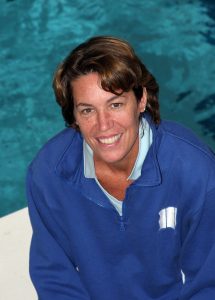 we used to run by this horrific line of streets—with garbage that had been out from the night before—and that air, that’s where I really had to suck it up to stay up with the guys.”
we used to run by this horrific line of streets—with garbage that had been out from the night before—and that air, that’s where I really had to suck it up to stay up with the guys.”
She was still in Singapore when she felt the lump in her breast. Raynolds knew immediately what it meant. Her mother and sister carried the BRCA2 gene mutation. They were the same age, 51 years old, when they were diagnosed with cancer.
Back home, she treated the breast cancer with radiation. But it soon spread to her ovaries and she needed chemotherapy. She spent the summer of 2016 split between chemo and practice, taking a week from the team, then going back for another two. At her weakest, the kids kept her spirits high.
“I honestly felt like the luckiest cancer patient alive,” she said. “I would look around the hallways and the waiting rooms and the infusion rooms, and realize that I have this community that cares about me. I just felt beyond lucky, like I wanted to share my team with the other patients. When you have a group of 40 kids help you shave your head, and are willing to watch your hair fall to the ground…” her voice trailed off. “They walked through the valley of it with me, and I’m grateful.”
For most coaches, showing weakness is never easy. When she felt her worst, Raynolds spent a few extra days away, feeling incapable of leading the team.
But the kids were there for her. A teammate compiled a video, sending it to Raynolds as a surprise. It showed each swimmer saying one word they felt described their coach. The kids jumped, danced and shouted words like “determined,” “vivacious,” “inspiring” and “zesty” into the camera—hardly words of pity.
Cox’s training for the Olympic trials fell in the middle of Raynolds’ chemotherapy treatments. The two adjusted the swimming schedule and moved forward.
“She totally persevered and was really strong throughout it all,” Cox said, “even when it was really hard to be strong because of the emotional and physical demands that it takes. I was aware of that and I know she really wanted to put on a strong front. But I knew that she was strong, no matter how she handled it.”
Doctors declared Raynolds cancer-free this past September. Now, she feels cancer has made her more compassionate, more able to accept and appreciate kindness.
“I feel that the color I’m adding is this thing called true compassion for self and others,” she said. “True compassion is an understanding that things are happening exactly the way they’re supposed to. Not the way we deserve, none of that, just that things in life are happening the way they’re supposed to. Anything is possible if you just really want to do it. I lose myself in what’s possible now.”
And her relationships with individual team members has grown more valuable. When Hansen qualified for the Summer Junior Nationals, Raynolds was in chemo and couldn’t join him. So he texted her: “I wish you were here.”
“He doesn’t know that that’s so special to me,” she said. “He means the world to me, this kid.”
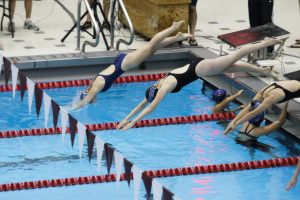 In an interview with Vermont Public Radio, Cox called Raynolds her “backbone.” The tiny gesture of gratitude, Raynolds said, meant more than any accolade.
In an interview with Vermont Public Radio, Cox called Raynolds her “backbone.” The tiny gesture of gratitude, Raynolds said, meant more than any accolade.
Her coaching style, which has always been based in energetic selflessness, has carried new meaning. When Raynolds approaches a pool deck, she strives to leave her personal life behind.
“I’ve always imagined that it’s like stepping into a circle,” she said. “It’s an ancient Native American thing called the ‘circle of stones’—that’s when I become nothing but for them. Nothing else but for them. How do you put that into words? It feels like something goes up my backbone. I become a posture, so to speak. I am here for them, my vessel is completely for them, and that’s it. Nothing else.”

